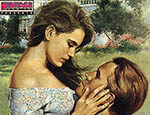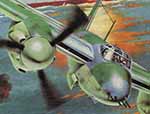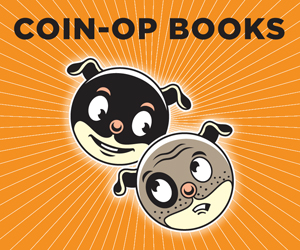Yesterday, word got out that the long-running UK comics anothology The Dandy had halted its digital publication plans and that last week’s edition was the final one. It was only last year that publisher DC Thomson discontinued its print version.
At that time, our Tony Ingram wrote the below piece, which we’re reproducing as a salute to the great stories produced in The Dandy, which will now only live on in its Annuals, released every Christmas.
It’s been 75 years since The Dandy, DC Thomson’s long-running humour comic, was first unleashed on the world, and this week the world’s third longest running comic finally shuts up shop for good…as a print magazine, at least. Time for a trip down memory lane…
 The first issue of The Dandy Comic (a name which was probably quaint and dated even then, but which nevertheless became loved by generations of kids totally oblivious to its meaning) was dated 4th December 1937, and it ushered in a new era for British comics. Probably the most noteworthy thing about that first issue was the fact that, unlike other comics of the time, it used the now customary (but back then, in British comics at least, uncommon) speech bubbles in panel, rather than having descriptive text under the panel, something which soon became common practice for pretty much everyone (except, for some reason, Rupert the Bear).
The first issue of The Dandy Comic (a name which was probably quaint and dated even then, but which nevertheless became loved by generations of kids totally oblivious to its meaning) was dated 4th December 1937, and it ushered in a new era for British comics. Probably the most noteworthy thing about that first issue was the fact that, unlike other comics of the time, it used the now customary (but back then, in British comics at least, uncommon) speech bubbles in panel, rather than having descriptive text under the panel, something which soon became common practice for pretty much everyone (except, for some reason, Rupert the Bear).
Long-running Dandy stars Desperate Dan and Korky the Cat were both on hand for that first issue and have been a more or less constant presence for most of the decades since, though countless other strips – and, in the early days, text stories – have passed through The Dandy’s pages in that time, from the boarding school antics of Winker Watson to the unlikely adventures of sheepdog superhero Black Bob (a star in his own right, for a time). Curiously, the people actually behind the comic have been rather more of a constant; original editor Albert Barnes (supposedly the model for Desperate Dan’s famous chin) remained in post until 1982, a not unimpressive 45 year run, and only three others have held the post since! Many of the creators, though officially freelancers, have likewise turned The Dandy into a way of life.
The Dandy Comic (the ‘Comic’ part wasn’t dropped until July 1950) quickly became a favourite with Britain’s kids, as did its younger sibling, The Beano, launched in July 1938 (the same year which saw the publication of the first Dandy Annual, though it wouldn’t be referred to as such for decades). Even the paper shortages of World War II couldn’t prevent the two titles from remaining a permanent fixture of British life, though Thomson’s were forced to reduce their frequency; from 6th September 1941-30th July 1949, The Dandy went fortnightly, alternating with The Beano until the shortages were over and life in Britain had returned to something approaching normal. Dandy remained weekly until 2007, when it was dropped back to fortnightly frequency once more.
Unfortunately, while the 1950s were something of a Golden Age for The Dandy, with sales sometimes exceeding one million copies of a single issue, from the 1960s onward the comic’s fortunes began to fade. In part, this was due to the gradual decline in comic sales in the UK as a whole, something was has continued remorselessly ever since, but The Dandy was also not helped by the fact that the early 1950s saw a radical overhaul of The Beano, which gained several new characters (including Dennis the Menace, Minnie the Minx, Roger the Dodger and The Bash St. Kids), who were immediately popular with the readership and had an anarchic quality which made The Dandy look rather old-fashioned and conservative by comparison.
If The Dandy was now playing second fiddle to The Beano it was still streets ahead of many other comic titles in popularity and, indeed, outlasted most of DC Thomson’s output. In the Eighties, two other titles – Nutty and Hoot – both fell by the wayside and were merged with Dandy, the former bringing the comic a new readers’ favourite in the absurd shape of the comedy superhero Bananaman, while the latter donated terrible toddler Cuddles, who joined forces with pre-existing Dandy star Dimples (another battling baby) to become the long running ‘Cuddles & Dimples’.
Bananaman, in particular, became enormously popular, eventually even getting his own TV cartoon series for a time. However, nothing could stop the gradual decline in sales, which over the next twenty years reduced the mainstream British comics industry to a shadow of its former self. And while The Dandy was still hanging in there long after most of its former stable mates and rivals had vanished into memory and nostalgia, it couldn’t continue to shed sales on a more or less weekly basis and not be affected by it. In October 2004, the comic underwent a radical revamp, the old style newsprint format being replaced by a glossy magazine look, unfortunately reflected by a price increase, while the content began to be updated to reflect the changing sensibilities of its audience. Unfortunately, this had little effect on the falling sales. But DC Thomson was not yet ready to give up on The Dandy.
In August 2007, The Dandy was dropped back to fortnightly frequency and re-titled (somewhat desperately) Dandy Xtreme, now marketed as a “lifestyle magazine for the under-tens”. This new look Dandy was a kind of hybrid of glossy magazine and traditional comic, now priced at a rather steep £2.50 and featuring a mixture of traditional comic characters, celebrities and cartoon characters, and features on TV, movies and other items of interest to the modern eight-year-old sophisticate. The debut of Dandy Xtreme was much hyped, but it was perhaps predictably not a tremendous success and, indeed, actually alienated some long-time fans. The experiment ended in October 2010, when Dandy returned to its former weekly comic format and the ‘Xtreme’ tag was unceremoniously dropped.
The yet again revamped Dandy abandoned most of its former strip stars except for Desperate Dan and Bananaman (though the by now long absent Korky the Cat made a long overdue return of sorts, albeit in a radically altered form and now as a three-panel strip instead of his former one or two pages). Celebrity ‘guests’ became a regular feature, (though quite what the comics younger readers made of some of them is a question probably best left unasked) with TV favourite Harry Hill getting a regular cover spot for a while, and new creators were given a chance to reinvigorate the title, with mixed results.
 Ultimately though, it was by now obvious to all that The Dandy’s days were numbered, with speculation rife that it would at some point go the way of so many titles of the past and be ‘merged’ into the seemingly immortal Beano. In the event, that has not happened, a clean break with the past seemingly being the preferred option. The Dandy, it has been announced, will continue in an online format, but the once famous logo has now seemingly been seen on newsagent’s shelves for the last time (at least unless, in keeping with company tradition, DCT continue to publish Dandy Annuals after the demise of the comic itself).
Ultimately though, it was by now obvious to all that The Dandy’s days were numbered, with speculation rife that it would at some point go the way of so many titles of the past and be ‘merged’ into the seemingly immortal Beano. In the event, that has not happened, a clean break with the past seemingly being the preferred option. The Dandy, it has been announced, will continue in an online format, but the once famous logo has now seemingly been seen on newsagent’s shelves for the last time (at least unless, in keeping with company tradition, DCT continue to publish Dandy Annuals after the demise of the comic itself).
A sad but pretty much inevitable development, but one which in no way diminishes the phenomenal achievements of The Dandy, a comic which survived not only World War II but 75 years of changing times and changing tastes, and which will not soon be forgotten.




















